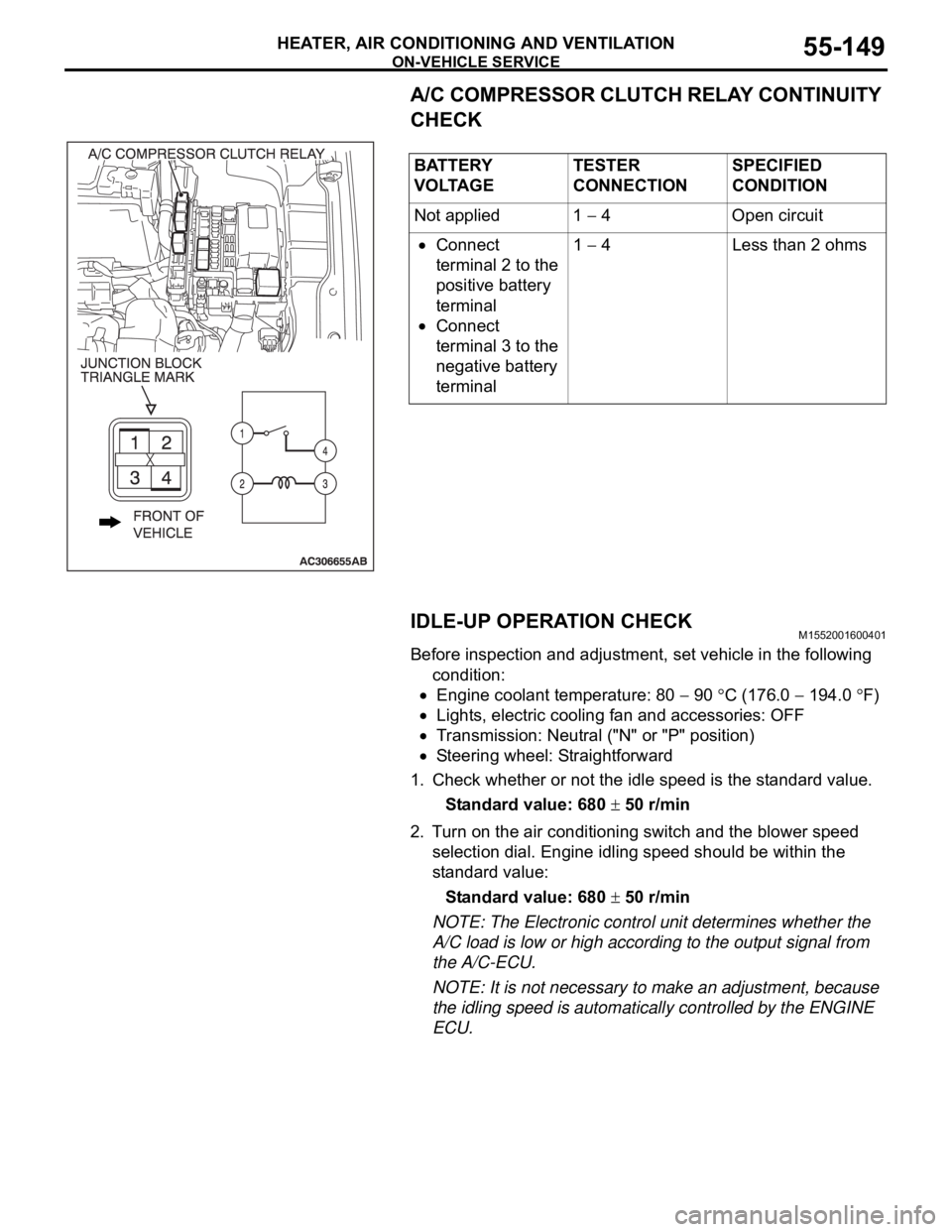Page 18 of 1500

SWS DIAGNOSIS
SIMPLIFIED WIRING SYSTEM (SWS)54B-18
Front-ECU, P/W, S/R
NOTE: For item No.70, the diagnostic tool
MB991958 (MUT-III Sub Assembly) also displays
"NG" under "ECU COMM Check" when it displays
"NO ACK" under the front-ECU check.NOTE: For item No.72, the diagnostic tool
MB991958 (MUT-III Sub Assembly) also displays
"NG" under "ECU COMM Check" when it displays
"NO ACK" under the sunroof-ECU check.
The table below shows the service data and their
normal condition, which are displayed during the
"Function Diag." The column "Normal condition"
shows values that are shown when each operation is
made.
.
CHECK
ITEMITEM NO. DISPLAY ON
DIAGNOSTIC
TOOLCHECK CONDITION NORMAL
CONDITION
Response by
the
front-ECU70 FRONT ECU
ACKLighting switch: Other than OFF (excluding
when high-beam is on) or the wiper switch
is at position other than OFF (ignition
switch: ACC or ON)NORMAL ACK
Ignition switch: Other than ON
Lighting switch: OFF
Wiper switch: OFFSLEEP ACK
Lighting switch: HEAD
Headlights: at high beamHI-BEAM ACK
Other than the condition above NO ACK
Response by
the
sunroof-ECU72 S/R ECU ACK
1. Door switch: OFF
2. Ignition switch: ON
OFF
3. While sunroof is offNORMAL ACK
SLEEP ACK (after
approximately 30
seconds)
1. Ignition switch: ON or START
2. One of the sunroof switches is onINPUT CHECK to
NORMAL ACK
Other than the above conditions NO ACK
Page 59 of 1500

SYMPTOM CHART
SIMPLIFIED WIRING SYSTEM (SWS)54B-59
Headlamp and
taillampGeneral description concerning the headlamp and
taillampP.54B-257
The taillights do not illuminate normally. H-1
P.54B-260
The headlamps (low-beam) do not illuminate
normally.H-2
P.54B-264
The headlamps (high-beam) do not illuminate
normally.H-3
P.54B-268
When the passing switch is turned "ON," the
headlamps (low-beam or high-beam) do not
illuminate.H-4
P.54B-271
Headlights do not illuminate when the lighting
switch is at "TAIL," and "PASSING" position, but
illuminate at low-beam when the switch is at
"HEAD" position. At this position, the headlamps
cannot be changed to high beam by operating the
dimmer switch.H-5
P.54B-273
The taillamps, the position lamps, front parking
lamps or the license plate lamp do not illuminate.H-6
P.54B-275
One of the headlamps does not illuminate. H-7
P.54B-290
The high-beam indicator lamp does not illuminate. H-8
P.54B-301
Headlamp automatic shutoff function does not
work normally.H-9
P.54B-305
Headlamp dimmer switch automatic resetting
function does not work normally.H-10
P.54B-308
Flasher timer General description concerning the flasher timer
P.54B-309
Turn-signal lamps do not flash when the
turn-signal lamp switch is turned on.I-1
P.54B-310
Hazard warning lamps do not flash when the
hazard warning lamp switch is turned on.I-2
P.54B-314
One of the turn-signal lamps does not illuminate. I-3
P.54B-316
The turn-signal lamp indicator does not illuminate
normally.I-4
P.54B-335
Fog lamp General description concerning the fog lamps
P.54B-339
Fog lamps do not illuminate when the fog lamp
switch is turned on.J-1
P.54B-340
Fog lamps do not go out when the headlamps
(low-beam) are turned off while the fog lamps are
on.J-2
P.54B-345
One of the fog lamps does not illuminate. J-3
P.54B-345
The fog lamp indicator does not illuminate
normally.J-4
P.54B-350 SYSTEM SYMPTOM INSPECTION
PROCEDUREREFERENCE
PA G E
Page 95 of 1500
SYMPTOM PROCEDURES
SIMPLIFIED WIRING SYSTEM (SWS)54B-95
Light reminder tone alarm function
When the taillights or headlamps is the ON position, if the igni-
tion key is removed and the driver's door is opened, a tone
alarm will sound continuously to warn that the lamps are on.
However, if the taillights or headlamps have been turned off by
the headlamp automatic-shutoff function, the tone alarm will not
sound.
Seat belt tone alarm function
Page 484 of 1500

CHECK AT ECU TERMINAL
SIMPLIFIED WIRING SYSTEM (SWS)54B-484
FRONT-ECU
NOTE: Terminal voltages cannot be measured as the
front-ECU is installed directly on the relay box.
Therefore, this information is only for reference.
TERMINAL
NO.INSPECTION ITEM INSPECTION CONDITION NORMAL VALUE
1 Output to fog lamp relay When the fog lamps are on Battery positive voltage
2 Output to headlamp (high-beam) When headlights (high-beam)
are onBattery positive voltage
3, 4 Battery power supply (for
headlamp)Always Battery positive voltage
5 Battery power supply (for
taillamp)Always Battery positive voltage
6 Output to headlamp (low-beam) When headlights (low-beam) are
onBattery positive voltage
7 Battery power supply (for ECU) Always Battery positive voltage
8 Output to taillamps When taillamps are on Battery positive voltage
9
11
21 Output to windshield washer When windshield washer is on Battery positive voltage
22 SWS communication line Always 0
12 V (pulse signal)
23 Input of automatic stop signal to
windshield wiperWhen windshield wiper is on Battery positive voltage
24 Power supply to ignition switch
(ACC)Ignition switch: "ACC" Battery positive voltage
25 Input of backup signal from
headlamp switchHeadlamp switch: ON0 V
26 Input of backup signal to
windshield wiperWindshield low-speed wiper
switch or windshield high-speed
wiper switch: ON0 V
27 Output to windshield wiper
(low-speed)When windshield wiper is on (at
low speed)Battery positive voltage
28 Output to windshield wiper
(high-speed)When windshield wiper is on (at
high speed)Battery positive voltage
30 Power supply to ignition switch
(IG2)Ignition switch: "ON" Battery positive voltage
31 Ground Always 0 V
Page 573 of 1500
LUGGAGE COMPARTMENT
CONFIGURATION DIAGRAMS80-24
LUGGAGE COMPARTMENTM1801001500311
F-01 (2-GR) HIGH-MOUNTED STOPLIGHT
F-02 (2) HIGH-MOUNTED STOPLIGHT
F-03 (6) REAR COMBINATION LIGHT (RH)F-05 (2) TRUNK LID LATCH ACTUATOR
ASSEMBLY
F-06 (2) LICENSE PLATE LIGHTS
F-09 (6) REAR COMBINATION LIGHT (LH)
F-10 (2) FUEL DOOR LID ACTUATOR
Page 836 of 1500

AUTO A/C DIAGNOSIS
HEATER, AIR CONDITIONING AND VENTILATION55-135
Temperature
setting23 Temperature setting
actualIgnition switch: ON The actual setting
corresponds with
diagnostic tool
display.
Vehicle speed 26 Actual vehicle speed Ignition switch: ON The vehicle speed
corresponds with
diagnostic tool
display.
A/C compressor
drive request27 Compressor clutch Engine: ON
Compressor:
ONDiagnostic tool
indication: "ON"
Compressor:
OFFDiagnostic tool
indication: "OFF"
Illumination 15 Display lighting Ignition switch: ON
Lights: ON
Diagnostic tool
indication: "ON"
Lights: OFF
Diagnostic tool
indication: "OFF"
Engine speed 23 Actual engine speed Engine: ON The engine speed
corresponds with
diagnostic tool
display.
In/out air select
switch state3 In/out air select
switch Ignition switch: ON In/out air
switch: ONDiagnostic tool
indication: "pressed"
In/out air
switch: OFFDiagnostic tool
indication: "release"
Rear defogger
relay72 Rear defogger relay Ignition switch: ON
Rear defogger:
ONDiagnostic tool
indication: "ON"
Rear defogger:
OFFDiagnostic tool
indication: "OFF" MUT-III
DIAGNOSTIC
TOOL DISPLAYITEM
NO.INSPECTION ITEM INSPECTION REQUIREMENT NORMAL VALUE
Page 850 of 1500

ON-VEHICLE SERVICE
HEATER, AIR CONDITIONING AND VENTILATION55-149
A/C COMPRESSOR CLUTCH RELAY CONTINUITY
CHECK
IDLE-UP OPERATION CHECK
M1552001600401
Before inspection and adjustment, set vehicle in the following
condition:
Engine coolant temperature: 80 90 C (176.0 194.0 F)
Lights, electric cooling fan and accessories: OFF
Transmission: Neutral ("N" or "P" position)
Steering wheel: Straightforward
1. Check whether or not the idle speed is the standard value.
Standard value: 680
50 r/min
2. Turn on the air conditioning switch and the blower speed
selection dial. Engine idling speed should be within the
standard value:
Standard value: 680
50 r/min
NOTE: The Electronic control unit determines whether the
A/C load is low or high according to the output signal from
the A/C-ECU.
NOTE: It is not necessary to make an adjustment, because
the idling speed is automatically controlled by the ENGINE
ECU. BATTERY
V O LTA G ETESTER
CONNECTIONSPECIFIED
CONDITION
Not applied 1
4 Open circuit
Connect
terminal 2 to the
positive battery
terminal
Connect
terminal 3 to the
negative battery
terminal1
4 Less than 2 ohms
Page 985 of 1500

CHARGING SYSTEM
ENGINE ELECTRICAL16-8
10.With the engine running at 2,500 r/min, turn the
headlights and other lights on and off to adjust the
alternator load so that the value displayed on the
ammeter is slightly above 30 A.
Read the voltmeter. Voltage reading at or below
limit value means voltage drop between alternator
and battery is OK.
Limit value: maximum 0.3 V
NOTE: When the alternator output is high and the
value displayed on the ammeter does not
decrease to 30 A, set the value to 40 A. Read the
value displayed on the voltmeter at this time.
In this case the limit value becomes maximum 0.4
V.
Adjust the engine speed by gradually decreasing
it until the value displayed on the ammeter is 30
A. Take a reading of the value displayed on the
voltmeter at this time.11.If the value displayed on the voltmeter is above
the limit value, there is probably a malfunction in
the alternator output wire. Check the wiring
between the alternator "B" terminal and the
positive battery terminal (including fusible link).
If a terminal is not sufficiently tight or if the
harness has become discolored due to
overheating, repair and then test again.
12.After the test, run the engine at idle.
13.Turn off all lights and turn the ignition switch to the
"LOCK" (OFF) position.
14.Disconnect the engine tachometer or diagnostic
tool.
15.Disconnect the negative battery cable.
16.Disconnect the ammeter and voltmeter.
17.Connect the negative battery cable.
18.Run the engine for 10 minutes at an idle.
OUTPUT CURRENT TESTM1161001000670